Updated: 15-Nov-2021
From the "Fabbrica Italiana Automobili Torino" SpA" its origins are known in 1899, but the construction of aviation engines started around 1908, as "Fiat Aviazione SpA", a subsidiary of the former.
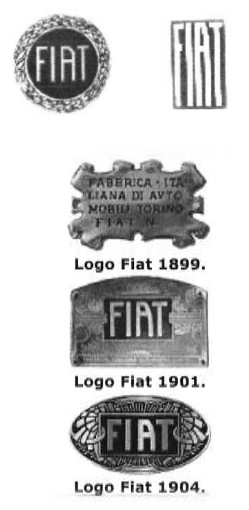
"Various Fiat logos"

"Current Logo"
-A first engine was the air-cooled V-8 with cylindrical fairing, fan and crank start.
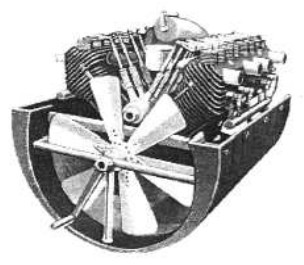
"First Fiat V-8"
-The V-8 received the official specification of SA-8/75.

"Fiat SA-8 / 75"
-The engine was air-cooled, and it had a tubular fairing with the distribution gear in sight.
-The S-55 from 1912 was also a V-8.
-Certainly, in a recent location the S-55 is an 8-cylinder engine from 1912, with a V of 90°.
-At that time they allready used four valves per cylinder and with camshafts on the cylinder heads. They were water-cooled.

"Fiat S-55"
-The Turin Polytechnic shows an inline Fiat S-76A for airships.
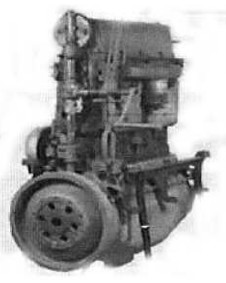
"Fiat S-76A"
-For airships, we see the twin assembly consisting of the coupling of two individual engines with upward drive transmissions and at a certain angle as we see in the below illustration.
-We deduce therefore that the engine-assembly was in the center and in a lower gondola.
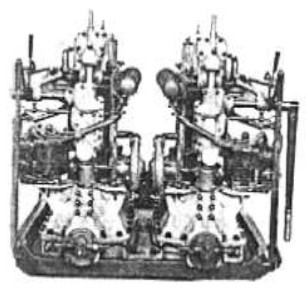
"Twin assembly"
-We see clearly that they are S-54 or slightly derived engines.
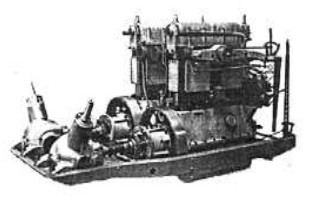
"Magnificent aspect of the installation"
-They were water cooled and could maneuver independently.
-A Fiat engine licensed by Mercedes was mounted on the Austrian Hopfner S1.
-In the middle of the 1914-18 war, the Fiat A-10 -inspired by the Mercedes D-1-, had 6 cylinders in line and gave 100 CV of power.

"Fiat A-10"

"Fiat A-12 schematic diagram"
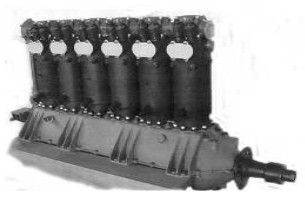
"A-12 at the museum in Vigna di Valle -incomplete"
-In 1917, the older brothers of the previous engine, were the A-12 and A-12bis, with 6 upright inline cylinders giving between 260 and 300 CV.
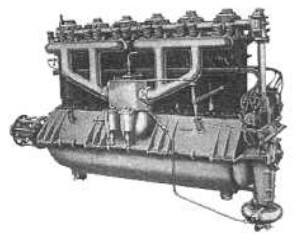
"A-12"
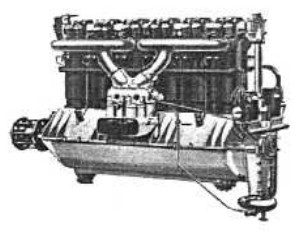
"A-12 bis"
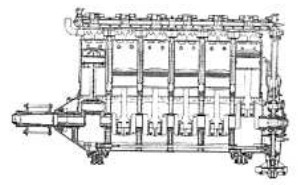
"A-12 bis, schematic diagram"
-From the A-12 series, more than 13,000 engines were delivered.
-In the field of Diesel engines Fiat experimented with the ANA models, in 1930. These engines were based on the inline 6 cylinder A-12bis, obtaining 220 CV at 1,700 rpm.
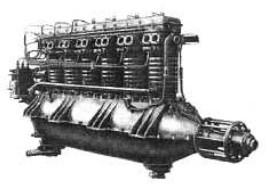
"Fiat AN-1"
-It was followed by the AN-1 that gave 180 CV at 1,600 rpm with a maximum of 220 CV at 1,700 rpm as well.
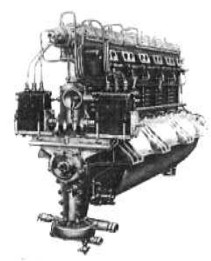
"AN-1, rear view"
-In the rear view of the AN-1 we see the two monobloc injectors, feeding three cylinders each.
-The AN-2, replaced the AN-1 and was improved, the cylinders had a diameter of 140 mm and the stroke of the piston was 180 mm, with a displacement of 16'627 lts.
-The power was sensibly the same.
-In 1918, the A-14 appeared with a power of 650-700 CV. Among other aircraft, it was mounted on the Macchi M-19.
-The A-22 and AS-2 are derived from it, very similar V-12 engines.
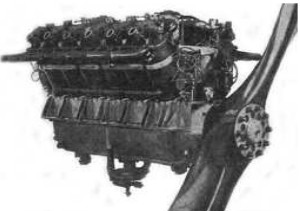
"Fiat A-14"
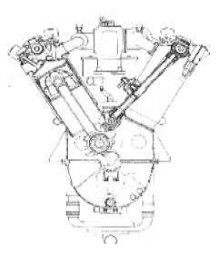
"Fiat A-14, schematic diagram"

"Fiat A-14"
-The A-14 that we see in an outline allows to see in detail the formed V, distribution, and valve mechanisms. On this page we have a nice 3/4 rear perspective.
-The 12-cylinder A-15R in V at 60° (although the exhaust ports do not seem to indicate this) had 18'696 dm3 of total displacement with four valves per cylinder. It had 4 naturally aspirated carburetors and was geared at 1.51: 1.
-The power was 325 CV at 2265 rpm. This engine was built in a few experimental units, around 1918. The designer was Mr. Giulio Cesare Cappa.

"Fiat A-15R"
-The A-16 was another 12-cylinder V-engine that gave 600 CV at 2,300 rpm, with gear, rotating to this regime the propeller did it at 1,600 rpm. It had almost 2000 cu. in. of displacement.
-The A-18 was a radial engine that also was experimental. This engine was from 1917 / 1918, and was projected by Cappa as well.

"A-18 front view"
-The A-18 was one of the few water-cooled radial engines. It had 9 cylinders with 18 liters of total displacement.

"A-18, rear view"
-It had four valves per cylinder and only two double-effect rockers, each controlled by a single rod.
-It gave 320 CV at sea level rotating at 2,000 rpm.
-It was Fiat's first fixed radial engine at a time when the rotary radial still proved its efficiency.
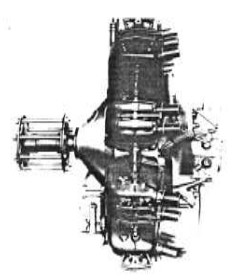
"A-18, side view"
-In the style of its contemporary Salmson, also water cooled. In the side and rear views we can see the water ducts joined by the cylinder bases. The carburetor was at the front and the two magnetos at the rear.
-The A-19 is a V-12 again, and came from the "Ufficio Progetti Fiat Avio", directed by Cappa. The cylinder blocks were at 60° and the V was upright.
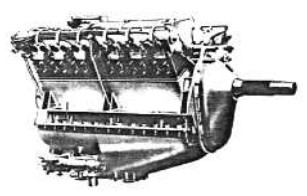
“Fiat A-19”
-It had a gear and a compressor, with almost 10 dm3 of total displacement. The power reached 350 CV at 3,500 crankshaft rpm, the propeller was geared at 1.733 to 1. The design corresponds to the year 1923 and few units were built, almost experimental.
-In 1925 the Fiat stopped giving continuity to the above mentioned engines and started with a new family, the A-20, A-22, A-25, AS-2 and A-24. All of them were liquid-cooled, 12-cylinder V-engines.
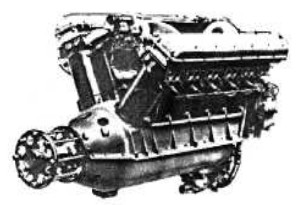
"Fiat A-20"
-The A-20 was a V-12 at 60° with powers between 430 and 460 CV, depending on the version. But the A-20A gave 410 CV.
-The water pump is visible under the oil sump and the carburetors between the cylinder blocks.

"Fiat A-20A"
-The magnetos at the rear and placed laterally. Camshafts at the cylinder heads. These engines were from the year 1925.
-The A-22, from 1926, with cylinders of 135 x 160 mm, giving a capacity of 27.48 dm3 and power of 550 CV.

"Fiat A-22"
-The Fiat A-22 was offered with different compression ratios.
-Thus there was the A-22T with a compression ratio 5.6 to 1 and 590 CV at 2,000 rpm.
-The Fiat A-22S with a 6.1 : 1 compression ratio and the A-22A with a compression ratio of 7.5 : 1.
-The A-22R engine is geared, as we see below.
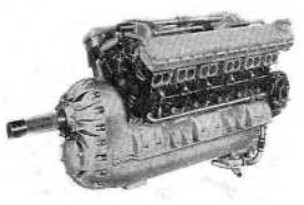
"Fiat A22R"
-The geared version A-22R delivered 610 CV and the A-22T gave 590 CV.
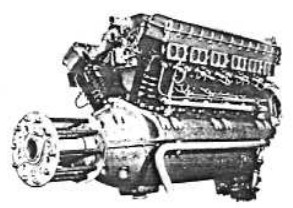
"A-24T"
-The A-24 engine is already due to another great designer, Mr. Tranquillo Zerbi. It is a simple version, and the experimental A-24T had a valve system patented by Fiat.

"A-24R"
-The A-24R, version with gearbox, was one of the best engines of the Fiat "school". This engine is from 1931, and it gave 700 CV with the propeller rotating at 2,050 rpm.
-The A-24R just like the A-24 had similar benefits but the former was more used in civilian and military aircraft than its predecessor. It was a very robust engine.
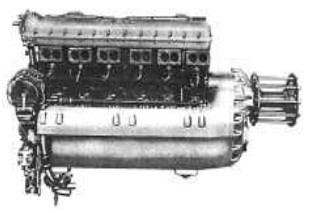
"A-24R"
-We see the A-24R on the right side, with gearbox and giving 720 CV.
-T. Zerbi (born in 1891 and died in 1939), was the designer of the A-25.
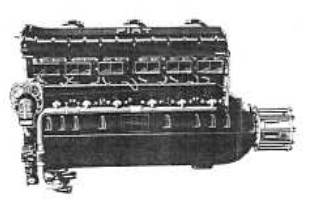
"A-25"
-The A-25 from the V-12 series, was developing 950 CV with 54.475 dm3 of total displacement and therefore it was a bigger engine.
-It had four valves per cylinder and two camshafts on top of the cylinder heads.
-Exceptionally, it had 4 spark plugs per cylinder and four magnetos.
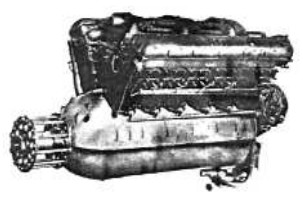
"A-25"
-Some 400 units were built, installed on the BR-2, BR-3 aircraft and the BR-4 prototype.
-It was the winner of the Bibescu Cup in 1931. In the second illustration of the A-25, we can see the two magnetos on the left side of the engine. It delivered 950/1000 CV.
-The A-26R with an important gearbox was a direct descendant of the A-24R although it remained in few experimental engines.

"A-26R"
-It gave 760 CV, the cylinder bed and gearbox was a monobloc, a formula experienced in the A-21. The gearbox had a patented shock absorber system. There were two quadruple carburetors placed between the V of the cylinder blocks. The engine was from the year 1932.
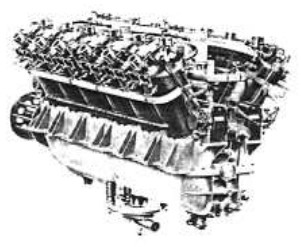
"A-30"
-The Fiat A-30, also due to T. Zerbi, was somewhat smaller, 600/700 CV at 2,750 rpm, with a 12-cylinder V at 60°.
-From the A-30 more than 2,500 copies were made, mainly destined to Fiat's own CR30 and CR32 biplanes.
-The Fiat A-30R engine, with an effective and even beautiful gearbox, had a development in the A-30RA
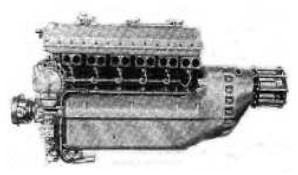
"Fiat A-30R"
-In the A-30RA the powers varied from 550 CV reaching 850 CV at momentary peaks at 2,900 rpm.
-The A-30RA bis version was almost identical to the previous one. Both with superimposed gearbox.
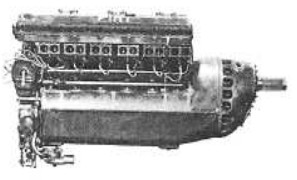
"A-30RA"

"Fiat A-30RA bis front view"
--The A-30 series was an important outcome for the Fiat brand.
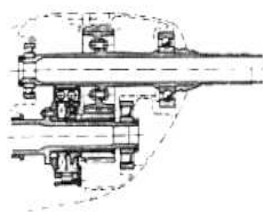
"Fiat A-30 gearbox”
-The famous airplane of the Spanish civil war, the Fiat CR-32, was powered by the A-30RA, giving 600 CV.
-The A-30RA bis was almost identical to the previous one. Both had a superimposed gearbox.
-The mentioned A-30RA and A-30RSbis were also descendants of the AS-5 sports engine and were the last of the V-12 series, together with the A-33 which in fact was an A-30RAbis with a compressor.

"Fiat A-33"
-The A-33RC35 was a logical development of the A-30RA and A-30RAbis. The main problem of these was the lack of a good compressor, so on its base a compressor was prepared after studying those of Hispano Suiza and Rolls Royce.
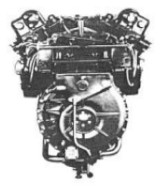
“A-33 rear view with its compressor”
-It was equipped with a powerful, complicated and original carburetor with automatic regulation depending on altitude and temperature. The compression ratio of 8 to 1 of the A-30 was reduced to 6 to 1, being able to use more common gasoline like NO-87.
-With the low octane gasoline mentioned above, the compressor device allowed to maintain the 700 CV at 3,500 meters of altitude. It was geared and had a compressor. The engine was designed by T. Zerbi, and Antonio Fessia (1901-1968) also intervened.
-Another engine is the Fiat A-33RC with compressor. Its power was 625/700 CV. The 625 CV was achieved at 2,600 rpm and the 700 CV at 2,600 rpm also but at an altitude of 3,500 meters.
-It is possible, therefore, that the complete reference of this engine is A-33 RC.35.

"Fiat A-33RC"
-The Fiat CR-33 aircraft was built especially for the flight test of this engine.
-An aside to present the engine that Fiat made with the same opposite-piston system as the Junkers Jumo.
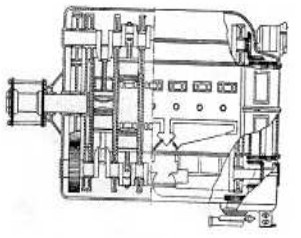
"Fiat in the Junkers Jumo style"
-Before going on to the WWII era when the Fiat focuses on the construction of radial engines (except the Tifone), we will go back a little to see the sports engines used in Cups and Rallies, especially the Schneider Cup.
-These engines used the initial letters of AS- (Aviazione Spinto).
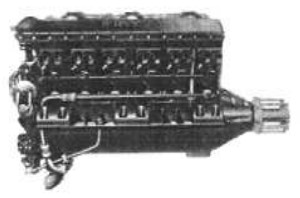
"Fiat AS-2"
-The first of these sports engines was the AS-2 that was a derivative of the A-14 and A-22. It was one of the first Fiat engines with rocker covers to close the valve mechanism.
-They were used in the 1926 and 1927 Schneider Cup on the Macchi M-39, with 800 and 880 CV, and they set the Cup record at 416 and 618 km/hr. respectively. It had the compression ratio increased to 6:1 instead of 5.3:1.
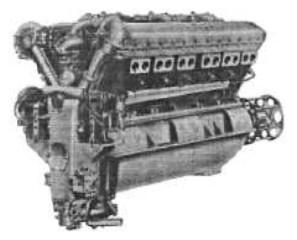
"Fiat AS-3"
-The AS-3 that reached 1,000 CV at 2,500 rpm was a development of the previous one for the 1927 Schneider Cup, but it did not cause any momentous detail.
-From this engine there is minimal information except the one that can be seen here.
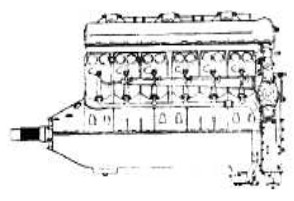
"AS-3 schematic diagram"
-The Fiat AS-5 was prepared for the C-29 racing aircraft in 1929.
-But it is best known for having given rise to the next model, the AS-6, which is nothing more than two supercharged AS-5 engines in a rear-to-rear tandem.
-The AS-5 was planned to be mounted on the Macchi M-67 from 1929.
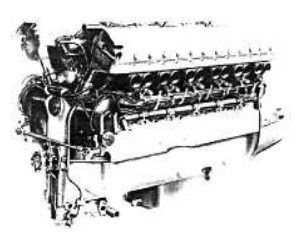
"Fiat AS-5"
-About the AS-6 we can write a lot. It was an exceptional engine and was mounted on the Macchi MC-72, which arrived too late to the 1930-1931 Schneider Cup, as the English Supermarine won the necessary three times before the MC-72 was presented.
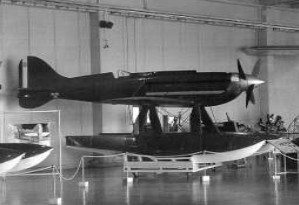
"MC-72 at the Vigna di Valle museum, today"
-But yes, later it broke the speed record. As it was said, it was an engine composed of two AS-5s joined in a rear-to-rear tandem. It was due to the great designer Tranquillo Zerbi.
-In total there were 24 cylinders, gearbox, compressor and double shaft to drive two coaxial and contra-rotating propellers.
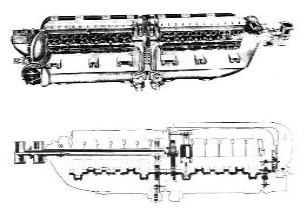
"AS-6, appearance and interior layout"
-The interior layout is marvelous. The power drives are at the central parts of the tandem.
-As the engines are placed rear-to-rear, their rotation is opposite one to the other, which facilitates the contra-rotating drive to the propellers through the reduction gearbox.

"AS-6"
-The rear engine drives the supercharger compressor. As an additional advantage there was a neutralization of the enormous torques generated by the two engines. Initially the power was 2,100/2,300 CV that soon reached the 2,800/3,000 CV.
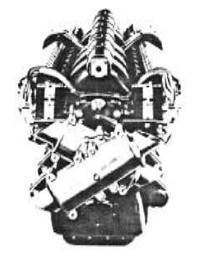
"AS-6, front view"
-Zerbi's intuition is demonstrated in the architecture of this great engine. It required eight carburetors and had a large intake manifold.
-In 1931 the power came to 2,300 CV, and in 1932 to 2,400 CV, tested in flight. In 1933 it reached 2,850 CV and already in 1934, the 3,100 CV, taking the plane to 709 Km / hr.
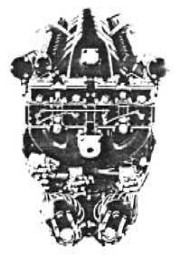
"AS-6, rear view"
-The fuel used was special, a compound of 55% benzine, 22% benzene, 23% ethyl alcohol and 1.5 parts per thousand tetraethyl lead.
-Without a doubt the AS-6 was Fiat's most glorious engine.
-From 1939 to 1940 the AS-8 appears, based on the same AS-6 idea, but this time the project was directed by Antonio Fessia and Carlo Felice.
-It was a special engine for speed records with 16 cylinders in a V of 45° with compressor and double drive gearbox for coaxial and contra-rotating propellers.
-At that time the Germans won the speed record and the Italians wanted to recover it by means of this engine.

"AS-8"
-The AS-8 took many constructive solutions from the AS-6. The difference was that it only had one crankshaft, long and with torsional effects that caused vibrations, although the pair of the propellers was neutralized among themselves.
-In 1940 it was placed on a test bench confirming the extraordinary robustness, something rare in these experiences.
-The engine power was 2500 CV despite having the power calculated for 2000 CV.
-It was another exceptional engine, it is said to be the best engineered and built engine in Italy at all times. It surpassed the AS-6 although it could not fly for not having the CS-15 plane and for the war.
-About the AS-8 engine we now have information on the complex interior system.
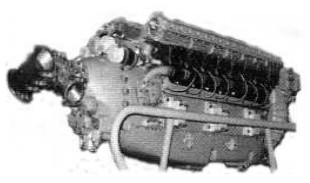
"Fiat AS.8"
-Above it is mentioned that it had only one crankshaft, two coaxial and contra-rotating propellers.
And that there were problems of torsional stress due to its length.
-Now we have another patent on the same engine, in which appear two crankshafts, one for each block of cylinders, operating separately.
-Curiously the V is distanced and with only 20°.
-The current one would have been: 720° for the two revolutions of the crankshafts (4-stroke) divided by 16 cylinders, would be at 45°.
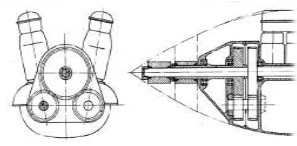
"Front gear solution"
-But due to the independence of both blocks with their own crankshafts, it does not matter the angle or the distance between them, except for what is in accordance with the gear sizes.
-In fact, the patent offers two possibilities.
-The first one is that of the previous figure with the gearbox at the front of the engine.
-The second solution that the patent provided is that of a gearbox for the left crankshaft at the front, and the gearbox of the right crankshaft at the rear, with a long shaft that penetrates the hollow shaft of the front gear propeller.

"Front gear outlines"
-The left crankshaft drives the front gears for the rear propeller.
-And below, the diagram with the rear gear and the shaft, we see in the illustration above, to reach the front propeller.
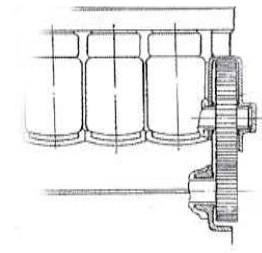
"Rear gearbox of the right block"
-Finally we show a silhouette of the plane to which the AS-8 was destined, the CS-15.
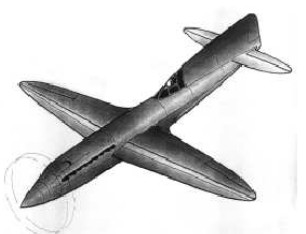
"Spectacular CS-15 of 1940"
-Following the unusual experiences, the same designer A. Fessia, for a ministerial contest, prepared a 16-cylinder, inverted V-engine, it was the Fiat A-38RC-14/45.
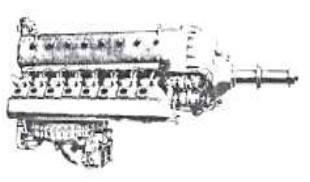
"A-38RC-14/45"
-It had a double drive output in the shaft for coaxial propellers, a two-speed compressor, and gear. It displaced almost 35 liters and the power was calculated at 1,200 CV.
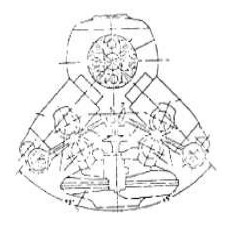
"Fiat A-38 outline"
-It was intended for the Fiat G-55 and Caproni Ca-365. The engine was very long with which the barycenter (center of gravity) of the plane was too much ahead.
-To reconcile this problem, Fessia, instead of placing the compressor behind the engine, which is common, he installed it underneath.
-The excessive length of the crankshaft and the torsional and equilibrium forces of the cranks, which were arranged at 45° and with counterweights arranged in a particular way to neutralize vibrations of 1st and 2nd order.
-To be a reality in 1941, it was left in a few experimental engines, because the Ministry commissioned Fiat the construction under license of the German engine DaimlerBenz DB-605A.
-The A-38 was therefore an exercise in love for mechanics, and was full of elegant solutions that had the fertile inventiveness of Fessia.
-The next engine to be treated, according to the previous introduction, is the RA-1050RC581.
-It is the Daimler-Benz 605A manufactured under license.
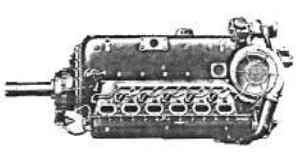
"RA-1050"
-As we already saw in the Daimler Benz chapter the engine data are the same for the Italian engine, which was called "Tifone".
-The following versions were available according to the aircraft they were intended for.
-It was prolific on both Macchi Castoldi 205 series, as on the Fiat G-55, Reggiane 2002, SIAI-91, -92 and -93, Caproni 331 and on the Umbra 902.
-The "Tifone", derived from model 605B, was geared at 1:0.533.
-The 605C was geared at 1:0.485.
-The 605AS had a larger compressor (1,200 CV at 8,000 meters of altitude).

"Tifone front and rear view"
-The 605D, E and F, had a compression ratio between 8.3 and 8.5, which is higher than normal, and they had water/methanol injection.
-It had several propeller gear steps, and it required higher octane gasoline (96 NO instead of the common 90 NO).
-The 605DC delivered 2,000 CV at 2,800 rpm and 1,800 CV at 5,000 meters of altitude.

"DB-605 at Vigna di Valle museum"
-The 605DB gave 1,800 CV at 2,800 rpm. The 605SB used gasoline of 87 NO and the 605SC used 96 NO
-The 605L had a mechanical two-step compressor, and used fuel of 96 NO. It delivered 1,700 CV at take-off.
-When Fiat was commissioned to manufacture the 605, the tools and machinery were different and new as well as the German construction solutions and details.

"Fiat A-50"
-Now we continue with the Fiat production. Having abandoned the formula V-12 with the A-33, we go to the A-50, which turned out to be a radial engine: a seven-cylinder small power 85/100 CV for light school and tourism aircraft.
-About 900 engines were made.
-It was designed by Tranquillo Zerbi in the year 1928.
-It was easy to maintain and had a simple construction. The A-53 and A-54 were derived from it.
-From the A-50, they made the A-50S version with more power, and the geared A-50R version that gave 110 CV.
-We obtained some interesting views of the Fiat A-50, a front and a rear view.
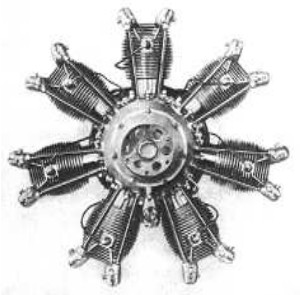
"Fiat A-50, front view"
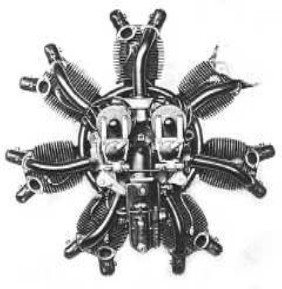
"Fiat A-50, rear view"
-The Fiat A-50 was head of the air-cooled family of this brand.
-And another photograph of the same engine on the factory's own assembly-disassembly bench.
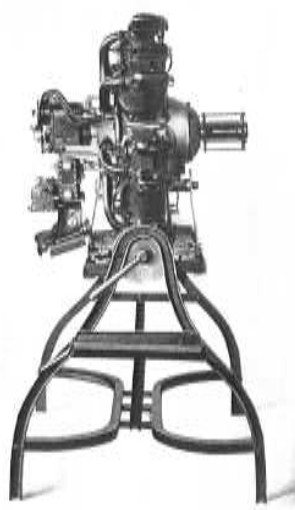
"Photograph from the maintenance manual"

"Fiat A-53"
-The A-53 that gave 120 CV also had 7 cylinders (with some influence of Walter Venus in the project). It was built in small series in 1931.

"A-54"
-The A-54, which in the illustration appears partly sectioned and with visible elements for educational purposes, was manufactured from 1932. Its power was 150 CV.
-The A-55 is owed to Zerbi. It had 4 valves per cylinder with a single control rod, a simple system patented by Fiat.
-This engine gave 380 CV, and was made in 1932, although in small quantities.

"Fiat A-55"
-The A-59RC, 9-cylinder radial, was the Pratt & Whitney "Hornet" S1EG, built under license, 650/700 CV.

"A-59RC"
-In 1934 it was made in small series with and without gear. Among the known aircraft that used it in Italy are the CR40bis and the CANT Z-206, both during the Spanish Civil War.
-The A-60, also designed by T. Zerbi in 1932, was an air-cooled, inverted, inline, four-cylinder engine that delivered 142 CV.

"A-60"
-The A-60 was similar to other engines of its time, especially the English, and it had an innovation that stood out above the others, even being a low-cost engine; it had the camshaft on the cylinder heads with all its moving mechanism. The following year a geared version came out.
-They were seen on the Fiat G2 and G5 as well as on the Caproni Ca-100.
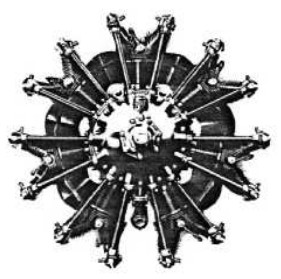
"A-70"
-In 1934, the prolific Zerbi designed the 7-cylinder A-70 that gave 205 CV, and was destined for sports aircraft. It already had a double rod per cylinder and classic valve control.
-The engine has a compressor and is suitable for inverted flight. In 1936, the A-70S came out with more power.
-The following year Zerbi, together with Fessia, designed the 14-cylinder A-74RC38 giving 840 CV at 3,800 meters of altitude and at 2,400 rpm. Some 9,000 engines were built between the almost 5500 by Fiat and the rest by Reggiane (see).
-The design is from 1934-35 and is based on the experience of the A-58 and A-59 mainly, this engine was intended for fighter aircraft.
-It had concentric epicyclic gear, compressor, fuel mixture heating, and automatic regulators.
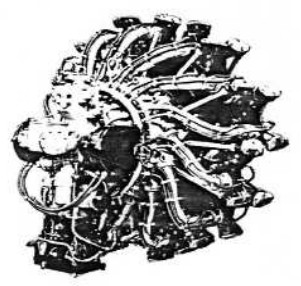
"A-74"
-In 1943, only with A. Fessia, the 14-cylinder A-76 is built. It is considered a derivative from the A-74 and A-75 (for the more known A-75RC53, we do not have an image).
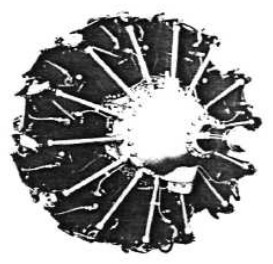
"A-76"
-As the A-75RC53 remained experimental in 1940, they focussed on the A-76, increasing the stroke by 10 mm compared to the A-74, which it was intended to replace. The version shown is the A-76RC40S.
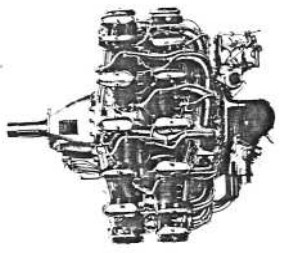
"A-80"
-The A-80RC41 was considered a great power engine for bombers, with 1,000 CV and 18 cylinders in double row. It had compressor and gearbox (RC). Soon the power became insufficient, so they developed the A-82 and A-83 to replace it.
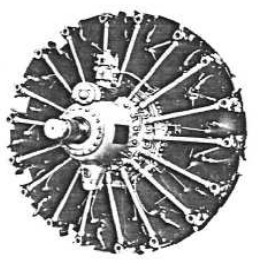
“A-82”
-The A-82RC40 also had 18 cylinders and reached 1,250 CV at 4,200 meters, rotating at 2300 rpm.
-It was built in 1942 in small series (the project dated from 1937 and was also from Fessia). This engine reproduces almost all the A-80, increasing the stroke with 5 mm and the rpm from 2100 to 2300.
-There was a recalculation of several components. The compressor was reprojected. The cylinder fins were increased in size. The one that was known as A-82RC42 already gave 1,400 CV.
Now we have arrived at the A-84, it seems that there was no further development of piston engines.
-Finished the WWII, the Italian air forces began to receive allied material and Fiat focused on maintenance (revisions and repairs) of the P & W R-985 and R-2800 engines, the RR Merlin 500, Packard V-1650- 7, etc.
-They also built parts for the J-35 jet.
-In 1953 Fiat built the DH "Ghost" -48 Mk1, under license, with 4,850 lbs of thrust. (2200 Kgs).
-Therefore, the company built a new factory for aircraft engines in Ligotto (near Turin).
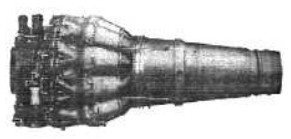
"Fiat Ghost"
-They also manufactured the Viper 601, 602 and 632 for the Fiat G-91 aircraft.

"Fiat Viper"
-The first modern jet engine (without considering the Caproni-Campini CC1 and CC2), designed and built entirely in Italy was the Fiat 4002.

"4002"
-This engine was intended for small and medium aircraft with a simple structural design and consequently easy to manufacture.
-The 4002.001, was an improved 4002.
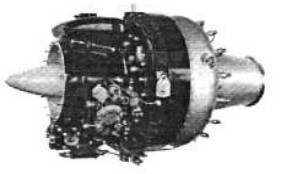
“4002.001”
-The 4023 was none other than the Bristol "Orpheus" 803, also destined for the next version of the Fiat G-91 fighter.
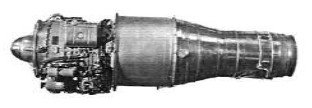
"Fiat 4023"
-The 4024 was an improved variant of the 4023. The development continued upto the 4032 that delivered 5,950 lbs. of thrust.

"4032"
-The 4700s were free turbines generating air for driving helicopter rotors.
-Its vertical position indicates it (they do not produce thrust, not even for lifting). The large output of air and burnt gases can be seen in the upper right part of the engine.
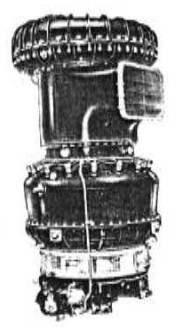
"4700"
--Fiat is adapting to the new circumstances and after the ephemeral passage through the design attempts of its own turbines, it comes to agreements with the North Americans and Europeans for collaboration.
-Together with Alfa Romeo, Fiat Aviazione builds the RB-199 for the Tornado (see also Turbo-Union).
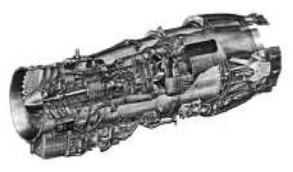
"RB-199"
-Fiat has two affiliated subsidiaries, such as Motoravia Sud and Turbomotori Internationale. Fiat Aviazione is known today as Fiat Avio.
The GE T-64, in its P4D version is built for the military transport aircraft G-222 of Aeritalia.

"Fiat-GE T-64"

"PW-2037"
-With P & W and MTU, it manufactures parts of the PW-2037, PW-2040 and PW-4000. This collaboration continues with the JT10-D and PW-308.
-The GE J-85, with Alfa Romeo as the first contractor, is produced for the G-91Y aircraft. With GE there are also parts manufacturing projects for the CF-6, GE-90 and T7000 / CT7.
-For the Starfighter F-104, it is the first contractor to manufacture the J-79.
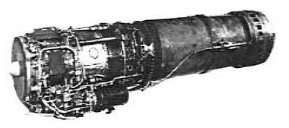
"Fiat J-85"
-With Rolls-Royce there is collaboration for the AMX aircraft, together with Celma in Brasil to manufacture the Spey 807. (see).
-With IAE it forms a group with other manufacturers to produce the V-2500.
-Fiat also participates in the construction of the Eurojet turbojet EJ-200 that is destined for the European Typhoon fighter.
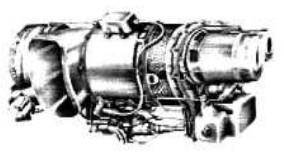
"Fiat Argo"
-There exists the auxiliary turbine "Argo", known as FA-150. It is a small auxiliary power group used as APU in aircraft, but also useful for land and sea applications. It gives 143 CV to the shaft, 48'5 Kg / min. of air, 345 Kpa of pressure, and 446 K of temperature.
-
The Fiat Avio group also manufactured solid rocket engines, such as P-80, and Zefiro 23 running on HTPB.
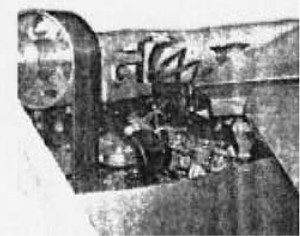
"Fiat Fire on homebuilt"
-Finally we mention that the car engines of this brand have been modified and adapted to the homemade construction aircraft.
-This is the case of the Fiat Fire coupled by EPA in Florence, with 1,100 cc and 56 CV at 5,500 rpm.
-A recent visit to the Polytechnic Institute (Polito) in Turin has served to clarify some concepts regarding the engines built by this brand.
-The first engines built with the initial letter "V", Veloce, were clearly derived from car engines that were already made.
-In such a way that the V-1 was an adaptation for Forlanini's dirigible "Citá di Milano".
-The V-2 and V-3 are known. Derivatives of automobile engines.
-In the main text, the S76A is shown, seen in reality it is a very high engine. It has four cylinders of 190 mm of diameter by 250 mm of stroke, that is to say, a long stroke. The engine is from the year 1913 and gave 300 CV at 1,200 rpm.

"Fiat S-76A"
-Beautiful looking, with its black cylinder blocks, crankcase and rocker covers in aluminum and many shiny bronze parts.
-Heavy looking, yes. It was used on airship M-1.
-In the year 1909, the S53A was made with four cylinders giving 50 CV. Sometimes 65/80 CV are attributed to this engine.
-The engine was installed on a Forlanini dirigible as well.
-The S71A is from 1910 and was installed by Forlanini on an "Idrovolante". It had four cylinders and gave 100 CV at 1,200 rpm
-In 1911, two S53A engines are used in twin installation for airships, giving rise to the new S54A engine.
-It is the unit that is interpreted in the main text as a possible twin assembly of S54 or "similar".
-Well, this point is clarified, now we know that there are two S53A engines coupled together.
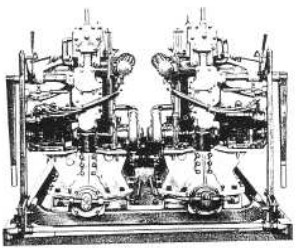
"Fiat S54A twin assembly"
-These engines were installed in type P airships: the P4 and P5 that were used in WWI and also on a German Ruthemberg dirigible.
-There is information of an S-55 and an S-56A, but the latter was already a V-8 that gave 75 CV at 1,300 rpm. Year 1912.
-From 1914 is The D-16 is from 1914, and gave 100 CV. It had six inline cylinders and was used again by Forlanini in one of his airships.
-We can make a chronological production list of Fiat engines in order of appearance.
-1915, the Fiat A10 and A10S, giving 95 and 120 CV respectively.
-1916, the A12 giving 210 CV with six inline cylinders.
-1917, the A12bis giving 300 CV with six inline cylinders.
-1917, the first V12, giving 600 CV the A14. The A14S, came out in 1922 with 700 CV at 1,600 rpm.
-1917, the A-18. A water-cooled radial engine.
-1918, the A-15 and -R version. V-12.
-1923, the A-19. V-12 giving 260 CV.
-1926, the AS-2. “Spinto” with 850 CV.
-1927, the AS-3. “Spinto" with 1000 CV.
-1928, the A-25 giving 950 CV at 1,700 rpm.
-Once it has been possible to check them "in situ", the engines at the Polito maintain a proportionality except one surprise, the A-25 is large and massive. It was intended for use in large single-engine and bomber aircraft.

"The A25 at the Polito museum"
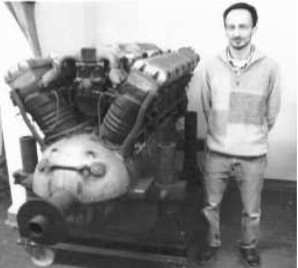
"The A-25 and curator Dr. Lorenzo Casalino"
-1928, the A50, first air-cooled radial engine.
-1930, the A50S and R.
-1930, the AN-1, first Diesel.
-1929/35 the A24 and R/T.
-1932, the A26R.
-1929, the AS5 with 1,000 CV.
-1931, the AS6 with 24 cylinders giving 2,400 CV (3,400 CV later).
-1931, the A53 radial giving 115 CV.
-1930/33, the A30R/RA/RAbis.
-1932, the A55 radial.
-1933, the A54 radial.
-1933, the A60 with four inverted cylinders.
-1934, the A70 with 7 radial cylinders.
-1935, the A33RC35.
-1935, the A59 and A78. The A74 and A80 as well.
-1940/41, the A75, A76, A38 and AS8.
-1942/43, the A82, A83, A84 and RA1050.
-1945, the A77.
Continua en FIAT segunda parte
Engines of FIAT, 1st part
Model: 4002
Arquitecture: Turbojet
Compressor/s: Centrifugal
Combustion chambers:
Turbines: single stage
Power / Thrust: --- / 550 Lbf
Weight: 219 Lb

"Fiat 4002"
Model: 4004
Arquitecture:
Compressor/s:
Combustion chambers:
Turbines:
Power / Thrust: / ---
Weight:
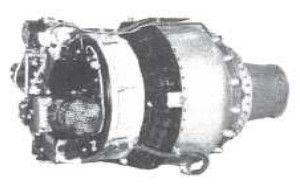
"Fiat 4004"
Model: 4023 (Orpheus Lic.)
Arquitecture: Turbojet
Compressor/s: 7-stage axial
Combustion chambers: can-annular with 7 flame tubes
Turbines: Single stage
Power / Thrust: --- / 5000 Lbf
Weight:

"Fiat 4023"
Model: 4024 (Orpheus up-rated, Lic.)
Arquitecture: Turbojet
Compressor/s: 7-stage axial
Combustion chambers: can-annular with 7 flame tubes
Turbines: Single stage
Power / Thrust:
Weight:
Model: 4032 (Orpheus up-rated, Lic.)
Arquitecture: Turbojet
Compressor/s: 9 stages
Combustion chambers: Annular combustor with 10 flame tubes
Turbines: Single stage
Power / Thrust: --- / 5952 Lbf
Weight: 1080 Lb

"Fiat 4032"
Model: 4301
Arquitecture:
Compressor/s:
Combustion chambers:
Turbines:
Power / Thrust: / ---
Weight:
Model: 4700
Arquitecture: Gas turbine
Compressor/s: Single sided centrifugal flow and gas generator single sided centrifugal flow compressor
Combustion chambers: Annular combustor with 16 burners
Turbines: 1-stage axial flow turbine and 1-stage axial flow free power turbine
Power / Thrust: 610GHP / ---
Weight: 152 Kg
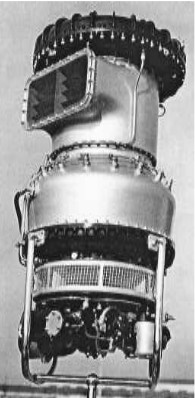
"Fiat 4700"
Model: A-10
Arquitecture: 6-cylinder In-line
Cooling: Liquid
Total Displacement: 9500 cc
Bore / Stroke:
Power: 100 CV
Weight: 190 Kg

"Fiat A-10"
Model: A-12
Arquitecture: 6-cylinder In-line
Cooling: Liquid
Total Displacement: 22 Ltr.
Bore / Stroke: 160 x 180 mm
Power: 300 CV @ 1700 rpm
Weight: 415 Kg
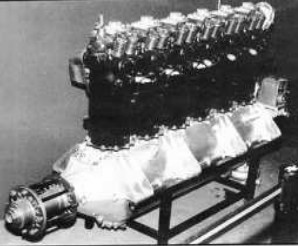
"Fiat A-12 engine"
Model: A-14
Arquitecture: 12-cylinder V-Engine
Cooling: Liquid
Total Displacement: 57 Ltr.
Bore / Stroke: 170 x 210 mm
Power: 700 CV @ 1600 rpm
Weight: 800 Kg

"Fiat A-14 fig.2"
Model: A-15R
Arquitecture: 12-cylinder V-Engine
Cooling: Liquid
Total Displacement: 20357 cc
Bore / Stroke: 120 x 150 mm
Power: 325 CV @ 2265 rpm
Weight: 362 Kg

"Fiat A-15R"
Model: A-16
Arquitecture: 12-cylinder V-Engine
Cooling:
Total Displacement: 2000 cu. in.
Bore / Stroke:
Power: 600 CV @ 2300 rpm
Weight:
Model: A-18
Arquitecture: 9-cylinder Radial
Cooling: Liquid
Total Displacement: 18 Ltr.
Bore / Stroke: 130 x 150 mm
Power: 320 CV @ 2000 rpm
Weight: 320 Kg

"Fiat A-18 front view"
Model: A-19
Arquitecture: 12-cylinder V-Engine
Cooling:
Total Displacement: 10 Ltr.
Bore / Stroke:
Power: 350 CV @ 3500 rpm
Weight:

"Fiat A-19"
Model: A-20
Arquitecture: 12-cylinder V-Engine
Cooling: Liquid
Total Displacement: 18700 cc
Bore / Stroke: 115 x 150 mm
Power: 460 CV @ 2300 rpm
Weight: 340 Kg
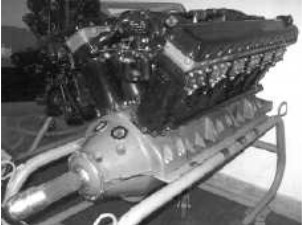
"Fiat A-20, 410 CV"
Model: A-22, -22T
Arquitecture: 12-cylinder V-Engine
Cooling: Liquid
Total Displacement: 27500 cc
Bore / Stroke: 135 x 160 mm
Power: 620 @ 2100 rpm
Weight: 455 Kg

"Fiat A-22"
Model: A-24, -24T, -24R
Arquitecture: 12-cylinder V-Engine
Cooling: Liquid
Total Displacement: 32300 cc
Bore / Stroke: 140 x 175 mm
Power: 700 CV @ 2000 rpm
Weight: 550 Kg

"Fiat A-24T"
Model: A-25
Arquitecture: 12-cylinder V-Engine
Cooling: Liquid
Total Displacement: 54475 cc
Bore / Stroke: 170 x 200 mm
Power: 950 CV @ 1700 rpm
Weight: 841 Kg

"The Fiat A25 at the Polito"
Model: A-26, -26R
Arquitecture: 12-cylinder V-Engine
Cooling: Liquid
Total Displacement:
Bore / Stroke:
Power: 760 CV
Weight:

"Fiat A-26R"
Model: A-30, -30R, -30RA, -30RAbis
Arquitecture: 12-cylinder V-Engine
Cooling: Liquid
Total Displacement: 24 Ltr.
Bore / Stroke: 135 x 140 mm
Power: 700 CV @ 2750 rpm
Weight: 480 Kg

"Fiat A-30RA"
Model: A-33, -33RC
Arquitecture: 12-cylinder V-Engine
Cooling: Liquid
Total Displacement:
Bore / Stroke:
Power: 700 CV @ 2600 rpm
Weight:

"Fiat A-33RC"
Model: A-38RC,
Arquitecture: 16-cylinder Inverted V-engine
Cooling:
Total Displacement: 34482 cc
Bore / Stroke: 138 x 145 mm
Power: 1200 CV
Weight: 790 Kg

"Fiat A-38RC-14/45"
Model: A-50, -50R, -50S
Arquitecture: 7-cylinder Radial
Cooling: Air
Total Displacement: 6600 cc
Bore / Stroke: 100 x 120 mm
Power: 110 CV @ 1800 rpm
Weight:

"Fiat A-50, front view"
Model: A-53
Arquitecture: 7-cylinder Radial
Cooling: Air
Total Displacement:
Bore / Stroke:
Power: 110 CV
Weight:

"Fiat A-53"
Model: A-54
Arquitecture: 7-cylinder Radial
Cooling: Air
Total Displacement: 7270 cc
Bore / Stroke: 105 x 120 mm
Power: 150 CV @ 2100 rpm
Weight: 150 Kg

"Fiat A-54"
Model: A-55
Arquitecture: 7-cylinder Radial
Cooling: Air
Total Displacement:
Bore / Stroke:
Power: 150 CV
Weight:

"Fiat A-55"
Model: A-58
Arquitecture:
Cooling:
Total Displacement:
Bore / Stroke:
Power:
Weight:
Model: A-59, -59RC Lic. PW,
Arquitecture: 9-cylinder Radial
Cooling: Air
Total Displacement:
Bore / Stroke:
Power: 700 CV
Weight:

"Fiat A-59RC"
Model: A-60
Arquitecture: 4-cylinder In line inverted
Cooling: Air
Total Displacement: 6560 cc
Bore / Stroke: 120 x 145 mm
Power: 142 CV @ 2200 rpm
Weight: 135 Kg
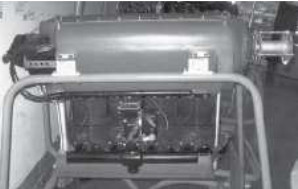
"Fiat A-60"
Model: A-70, -70S
Arquitecture: 7-cylinder Radial
Cooling:
Total Displacement:
Bore / Stroke:
Power: 205 CV @ 2000 rpm
Weight:

"Fiat A-70"
Model: A-74
Arquitecture: 14-cylinder Radial
Cooling: Air
Total Displacement: 31250 cc
Bore / Stroke: 140 x 145 mm
Power: 840 CV @ 2400 rpm
Weight: 590 Kg

"Fiat A-74"
Model: A-75RC53
Arquitecture: 14-cylinder Radial
Cooling:
Total Displacement:
Bore / Stroke:
Power:
Weight:
The A-75RC53 remained experimental.
Model: A-76
Arquitecture: 14-cylinder Radial
Cooling:
Total Displacement:
Bore / Stroke: 140 x 155 mm
Power:
Weight:

"Fiat A-76"
Model: A-78
Arquitecture:
Cooling:
Total Displacement:
Bore / Stroke: x
Power:
Weight:
Model: A-80
Arquitecture: 18-cylinder Radial
Cooling:
Total Displacement: 45720 cc
Bore / Stroke: 140 x 165 mm
Power: 1030 CV @ 2200 rpm
Weight: 750 Kg

"Fiat A-80"
Model: A-82
Arquitecture: 18-cylinder Radial
Cooling: Air
Total Displacement:
Bore / Stroke:
Power: 1400 @ 2300 rpm
Weight:

"Fiat A-82"
Model: A-84
Arquitecture: 18-cylinder Radial
Cooling:
Total Displacement:
Bore / Stroke:
Power:
Weight:
Model: AN-1, Diesel
Arquitecture: 4-stroke6-cylinder In-line
Cooling: Liquid
Total Displacement: 16630 cc
Bore / Stroke: 140 x 180
Power: 220 CV @ 1700 rpm
Weight: 390 Kg

"Fiat AN-1"
Model: AN-2
Arquitecture: 4-stroke6-cylinder In-line
Cooling:
Total Displacement: 16627 cc
Bore / Stroke: 140 x 180
Power: 220 CV
Weight:
Model: Argo (FA-150)
Arquitecture: Gas turbine
Compressor/s:
Combustion chambers:
Turbines:
Power / Thrust: 143CV / ---
Weight:
Used as APU

"Fiat Argo"
Model: AS- Viper 601, 602, 632 (Lic.)
Arquitecture: Turbojet
Compressor/s: 8-stage compressor (Viper 601)
Combustion chambers: Annullar cumbustor
Turbines: Two-stage turbine
Power / Thrust: --- / 3750 Lbf
Weight: 760 Lb

"Fiat Viper"
Model: AS-2
Arquitecture: 12-cylinder V-Engine
Cooling: Liquid
Total Displacement: 30955 cc
Bore / Stroke: 140 x 170 mm
Power: 800 CV @ 2500 rpm
Weight: 408 Kg
Derived from the A-14 and A-22.

"Fiat AS-2"
Model: AS-3
Arquitecture: 12-cylinder V-Engine
Cooling:
Total Displacement: 34600 cc
Bore / Stroke: 145 x 175
Power: 1000 @ 2400 rpm
Weight: 423 Kg

"Fiat AS-3"
Model: AS-5
Arquitecture: 12-cylinder V-Engine
Cooling: Liquid
Total Displacement: 25130 cc
Bore / Stroke: 138 x 140 mm
Power: 1000 @ 3200 rpm
Weight: 348 Kg

"Fiat AS-5"
Model: AS-6
Arquitecture: 24-cylinder V-Engine
Cooling:
Total Displacement: 50250 cc
Bore / Stroke: 138 x 140 mm
Power: 3100 CV @ 3300 rpm
Weight: 930 Kg

"Fiat AS-6"
Model: AS-8
Arquitecture: 16-cylinder V-Engine
Cooling: Liquid
Total Displacement: 34482 cc
Bore / Stroke: 140 x 140 mm
Power: 2000 CV
Weight: 715 Kg

"Fiat AS-8 fig. 2"
Model: CF-6 (GE Lic.+ Alfa Romeo)
Arquitecture: Turbofan
Compressor/s:
Combustion chambers:
Turbines:
Power / Thrust:
Weight:
With GE, Fiat also has parts manufacturing projects for the CF-6, GE-90 and T7000 / CT7.
Model: DB-605A (Tifone) (RA-1050)
Arquitecture: 12-cylinder Inverted V-engine
Cooling: Liquid
Total Displacement: 35760 cc
Bore / Stroke: 154 x 160 mm
Power: 1475 CV @ 2800 rpm
Weight: 700 Kg

"DB-605, inverted"
Model: DH Gost (Lic.)
Arquitecture: Turbojet
Compressor/s: Single stage centrifugal
Combustion chambers: 10 combustors
Turbines: Single stage
Power / Thrust: --- / 4850 Lbf
Weight:

"Fiat Ghost"
Model: EJ-200 (colaboracion)
Arquitecture: Turbojet
Compressor/s:
Combustion chambers:
Turbines:
Power / Thrust:
Weight:
Fiat participates in the construction of the Eurojet EJ-200 turbojet.
Model: Fire, motor coche convertido
Arquitecture:
Cooling:
Total Displacement:
Bore / Stroke: x
Power:
Weight:
Model: GE J-85 (Lic.+Alfa Romeo)
Arquitecture: Turbojet
Compressor/s: 8-stage axial-flow compressor
Combustion chambers:
Turbines: 2-stage turbine
Power / Thrust: --- / 1320 Kgf
Weight:
Versions with and without afterburner.

"Fiat J-85"
Model: GE, T-64 (GE Lic.)
Arquitecture: Turboshaft
Compressor/s: 14-stage high-pressure compressor. Axial flow
Combustion chambers: Annular combustors
Turbines: Axial, 2-stage high-pressure turbine, 2-stage low-pressure turbine
Power / Thrust: 4330HP / ---
Weight: 720 Lb

"Fiat-GE T-64"
Model: GE, T700/CT7 (GE Lic.+Alfa Romeo)
Arquitecture: Turboshaft
Compressor/s: 6-stage or 5-stage axial and 1 stage centrifugal
Combustion chambers: annular combustors
Turbines: 2-stage gas generator and 2-stage power turbine
Power / Thrust:
Weight:
Powers according to model between 1.535 shp and 2.638 shp.
Weights between 400 lb y 537 lb.
Model: GE-90 (GE Lic.+Alfa Romeo)
Arquitecture: Turbofan
Compressor/s: 10-stage high-pressure compressor and 3-stage lo
Combustion chambers:
Turbines: 2-stage turbine
Power / Thrust: --- / 97300 Lbf
Weight:
Above specifications for the GE-90-94B
Model: JT-10D (PW Lic.+MTU)
Arquitecture: Turbofan
Compressor/s: 1 fan, 4-stage LP, 12-stage HP
Combustion chambers: Annular combustors
Turbines: 2-stage HP, 5-stage LP
Power / Thrust: --- / 43400 Lbf
Weight: 7100 Lb
Model: Jumo, vert.opp. (Lic.)
Arquitecture:
Cooling:
Total Displacement:
Bore / Stroke: x
Power:
Weight:
Model: PW 308 (Lic.+MTU)
Arquitecture: Turbofan
Compressor/s: 4-stage axial, single stage centrifugal HP compressor
Combustion chambers: Annular combustor
Turbines: 3-stage LP turbine and 2-stage HP turbine
Power / Thrust:
Weight:
Model: PW-2037 (Lic.+MTU)
Arquitecture: Turbofan
Compressor/s: 6-stage intermediate and 6-stage HP
Combustion chambers: Annular combustors
Turbines: 1 HP stage, 1 intermediate stage, 3 LP stages
Power / Thrust: --- / 37400 Lbf
Weight: 7294 Lb

"Fiat PW-2037"
Model: PW-2040 (Lic.+MTU)
Arquitecture: Turbofan
Compressor/s:
Combustion chambers:
Turbines:
Power / Thrust:
Weight:
Model: PW-4000 (Lic.+MTU)
Arquitecture: Turbofan
Compressor/s:
Combustion chambers:
Turbines:
Power / Thrust:
Weight:
Model: RA-1050 (lic. DB-605A) “Tifone”
Arquitecture: 12-cylinder In line inverted
Cooling: Liquid
Total Displacement: 35760 cc
Bore / Stroke: 154 x 160 mm
Power: 1324 CV @ 2800 rpm
Weight: 756 Kg

"Fiat RA-1050"
Model: RB-199 (con otros manufg.)
Arquitecture: Turbofan
Compressor/s: 3-stage LP, 3-stage IP, and 6-stage HP
Combustion chambers: Annular combustors
Turbines: Single stage HP, single stage IP and 2 stage LP
Power / Thrust:
Weight:
With afterburner

"Fiat RB-199"
Model: Rockets: P-80, 23, 29, Avum, etc
Arquitecture:
Chambers:
Fuels:
Feed System:
Ignition:
Thrust:
Weight:
Model: S-55
Arquitecture: 8-cylinder V-Engine
Cooling:
Total Displacement:
Bore / Stroke:
Power:
Weight:

"Fiat S-55"
Model: S-76A
Arquitecture: 4-cylinder In-line
Cooling:
Total Displacement:
Bore / Stroke:
Power:
Weight:

"Fiat S76A"
Model: S54A
Arquitecture:
Cooling:
Total Displacement:
Bore / Stroke: x
Power:
Weight:

"Fiat S54A assembly"
Model: SA8/75
Arquitecture: 8-cylinder V-Engine
Cooling: Air
Total Displacement: 3 Ltr.
Bore / Stroke:
Power: 50 CV @ 2000 rpm
Weight:

"First Fiat V-8"
Model: Spey 807 (Lic. RR)
Arquitecture: Turbofan
Compressor/s:
Combustion chambers:
Turbines:
Power / Thrust:
Weight:
Model: V.2500 (en colaboracion)
Arquitecture: Turbofan
Compressor/s:
Combustion chambers:
Turbines:
Power / Thrust:
Weight:


